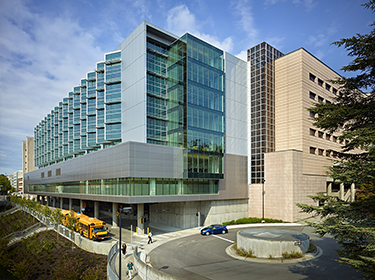|
Subscribe / Renew |
|
|
Contact Us |
|
| ► Subscribe to our Free Weekly Newsletter | |
| home | Welcome, sign in or click here to subscribe. | login |
Construction
| |
 |
July 29, 2021
The shape-shifting needs of the health care industry
Special to the Journal

McCain
|

Sama
|
Every industry manages facility change to some degree. Few industries, however, are as dynamic as health care. Even in the most stable of times, health care systems face the challenge of 24/7 operations, constant adaptation to new discoveries in care, shifting funding methods and the corollary space and design needs they create. Then came 2020. As we all know, the health care industry had to adapt quickly to the pandemic, a massive influx in high-acuity patients and the fallout that resulted in fewer preventive care appointments and elective procedures.
Health care professionals in the Puget Sound area and indeed around the nation showed us the true meaning of heroism and resiliency. They are rightfully seen as heroes for their extraordinary efforts in these challenging times. Thankfully, it appears that the worst may be behind us.
Resiliency and flexibility have played a leading role in determining the scope of construction and renovation projects in health care for decades. That trend will continue as future projects are developed and lessons learned from the pandemic — the increased need for fresh air, isolation/negative pressure rooms, specialty ingress/egress, temporary screening areas and spaces for caregivers to decompress, to name a few — are applied to drive better outcomes for patients, professionals and institutions.
Skanska and NBBJ have been jointly collaborating with our health care clients to deliver complex urban health care projects throughout the country for more than 25 years. As we reflect on the pandemic and the challenges health care institutions have faced this past year, it’s a good reminder that strong, collaborative partnerships between owners, designers and builders can help overcome even the most difficult situations.
Montlake Tower expansion
UW Medical Center
Boxed in on all sides by either buildings or roads, we were tasked with building a new patient tower over an active roadway while connecting with all levels of the active hospital towers. We began to think of these junctions as three-dimensional zippers.
Using 3D scanning technology to gather essential details, we were able to identify where an aluminum cover plate on a third floor window extended an inch too far when we could not be off by a single inch over a distance of 500 feet apart.
Another challenge was maintaining the existing intake air system during construction. To optimize the program, we needed to bisect the existing building’s primary air intake shaft, cutting off clean air to building occupants. Together, we conceptualized and built what we affectionately called “The Snorkel,” a five-story tall (with a one-story horizontal jog) air filtration system. The system was built high enough and included filters to clean the air to ensure continuous operations of the hospital during active construction.
Our collaborative team judiciously managed change and the budget throughout the design and construction phases. We regularly discussed the owner’s entire project investment, including soft cost in conjunction with the project’s “risk register,” a process often occurring now as part of progressive design-build projects. We examined each potential risk along with how the remaining contingency would be affected. Through proactive management of the owner’s entire investment, the team was able to add a beautiful fourth-floor courtyard, a project betterment that more than 50% of patient rooms now enjoy. We also recognized an opportunity created by changing market conditions, giving UWMC the option to add three floors to the building after construction had already started on the base scope. This was all accomplished with minimum impact to the construction schedule.
We learned that creativity — whether in use of technology, ways to look at budgets or how to overcome a five-story air intake problem — is one of the best problem-solving tools any collaborative team can have.
University Medical Center
LSU
Our team effort in New Orleans was to design and build a large health care campus that included replacing the famed Charity Hospital destroyed by Hurricane Katrina. This campus provides the only Level 1 Trauma Center in South Louisiana.
The campus incorporates more than 15 city blocks of compressive soils subject to settling with the whole of the city. Mitigation to ensure site and structure longevity included import of hundreds of thousands of pounds of Mississippi-dredged sand providing up to 6 feet of overburden across the entire site, and a network of wicks and pumps to expedite dewatering and compression of the soils. Coupled with eight pile driving rigs, this allowed timely placement of thousands of 45-foot-deep piles.
Working in a joint venture with MAPP, the team built the hospital, ambulatory care building and the central utility plant, raising all critical functions 22 feet above sea level — well above the FEMA base flood level and the Katrina flood. The elevated critical facilities include the entire emergency department, all HVAC and electrical equipment, and six emergency generators. We also built extensive storm-proofing to provide a shelter in place and seven-day islanded operations plan.
We learned that affective collaboration from planning to construction phasing could deliver a project exceeding expectations on time and on budget.
Jones Pavilion
Virginia Mason Medical Center
For the Jones Pavilion at Virginia Mason, our team confronted many challenges of an urban health care expansion. The project was built right next to surgery suites, and the surgical air intake was right in the middle of our excavation zone and required unique, temporary solutions to protect the clean air entering the building. Additionally, there was a challenge related to the floors in the existing facility not aligning with the necessary floor heights in the new building, which gave the team a unique opportunity to find a solution that would also be of valuable benefit to the hospital. Finally, the facility needed to be self-sustaining for 96 hours and built to withstand a once-in-a-century earthquake.
To overcome these challenges, the team developed a communication method and protocol with surgical nurses so that we could stop work at a moment’s notice so as not to have noise, vibrations or thumping disturb surgeons during procedures. We created new interstitial spaces that allow for independent floor-by-floor HVAC systems for maximum flexibility and isolation, when needed. We also designed the systems and infrastructure of the new building to be able to feed and support or replace infrastructure that was becoming outdated in the existing facility. The result was a brand-new hospital tower and an existing facility with a new lease on life thanks to the infrastructure support from the new tower systems.
This project reaffirmed our collective belief that challenges are just opportunities to innovate and think differently.
Whether it’s these three projects or others, such as Miami Valley Hospital in Dayton, Ohio, or Palo Alto Medical Foundation in San Carlos, California, we have learned a lot about how collaborative teams can bring value to projects. From overcoming extensive soil remediation challenges, to using hinge joints to allow buildings to flex during earthquakes, to renting warehouse space hosting multi-trade prefabrication at scale to save time and money, the ability for design and build teams to reliably adapt quickly is critical when what we’re building is where people will save lives.
We have found that a true partnership built on respect, trust and finding creative solutions together with our clients delivers the best outcomes for everyone. As health care institutions continue to evolve and as today’s challenges manifest themselves in new projects, adaptation, resiliency and collaboration will no doubt remain as core needs to both the health care construction process and health care in general.
Kevin McCain is executive vice president and general manager at Skanska USA Building in Seattle. Jose Sama is a health care partner at NBBJ.
Other Stories:
- Aggregation will drive a new hybrid science space
- Alternative delivery benefits health care in Washington
- Next-gen health care: Building healthier communities, economies
- Micro hospitals offer the right prescription
- Best practices in health care development and delivery
- How flexible design served OHSU during the pandemic
- The shifting need for design in health care services
- Evidence-based design improves dialysis treatment experience
- Compounding pharmacies provide community resource



